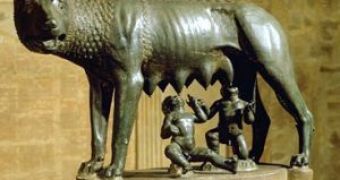The symbol of the ancient Rome was the Palatine Hill and as archaeologists expected, the investigation of the ancient site brought to light a trove of discoveries.
Amongst the findings is what could be the underground cavern where the legendary she-wolf (photo) nursed the legendary founders of Rome, Romulus and Remus, the abandoned twin sons of the god of war Mars.
Archaeologists are worried by the poor condition of the luxurious imperial homes that have forced the closure of much of the hill to the public.
Some key areas could be reopened to tourists by the end of the year, including frescoed halls in the palaces of the emperor Augustus and of his wife, Livia. The findings took place during the restoration works of the Augustus' palace. The core of the hill could be a long-lost place of worship believed to harbor the cave of the mythical she-wolf. "Experts used a probe to peer into the 52-foot-deep cavity and found a vaulted space decorated with frescoes, niches and seashells", said Irene Iacopi, the archaeologist in charge of the Palatine and the nearby Roman Forum
"It is too early to say for sure whether the worship place known as "lupercale''- from "lupa,'' Latin for she-wolf - has been found, but Roman texts say that it was close to Augustus' palace and that the emperor had restored it," Iacopi said.
"It was a very important symbolic place and we believe that it was well preserved. Archaeologists are now looking for the grotto's entrance," said Giovanna Tedone, an architect leading the work at the palace.
Other fresh discoveries include an ancient Roman sewer, insignia supposed to have belonged to the emperor Maxentius, terra-cotta statues and an alabaster tiger striped with gray marble.
The current condition of the hill is lousy: rainwater seeps through stones, roots pierce through bricks and retaining walls crack under layer after layer of construction, from the eighth-century B.C. Huts remains to a medieval fortress and Renaissance villas.
Palatine harbors nearly 500 buildings, from which only one quarter are at the surface, above the ground and currently just 40 % of the 67 acres can be visited. The latest closure came in November 2005, when a 16th-century wall collapsed one night in an extremely visited area near the Emperor Tiberius' palace, but even if nobody was hurt, this led to the closure of the area.
Specialists believe that the restoration of the ancient sewage system would help drain the rainwater. "Each year, 4 million people buy a ticket granting access to the Palatine and the nearby Colosseum, but 90 % of them just go to the ancient arena," said Culture Minister Francesco Rutelli. "$9 million will be available in 2007 for more restoration on collapse-prone areas such as Tiberius' palace."
The name Palatine entered in English as "palace" and is - of course - present in all Romance languages (French "palais", Spanish "palacio", Italian "palazzo", Romanian "palat").

 14 DAY TRIAL //
14 DAY TRIAL //